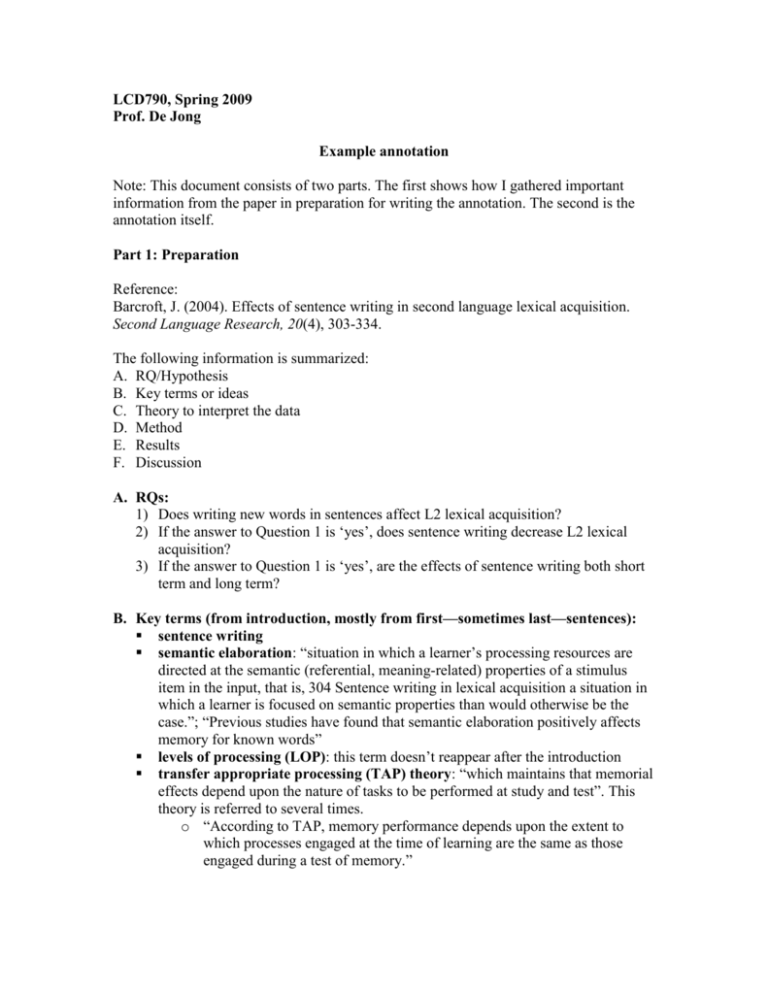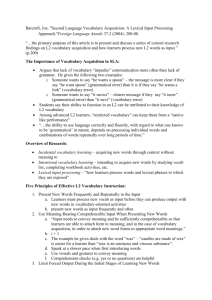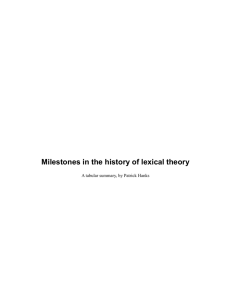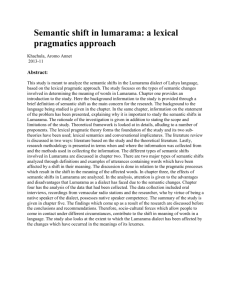Barcroft, J
advertisement

LCD790, Spring 2009 Prof. De Jong Example annotation Note: This document consists of two parts. The first shows how I gathered important information from the paper in preparation for writing the annotation. The second is the annotation itself. Part 1: Preparation Reference: Barcroft, J. (2004). Effects of sentence writing in second language lexical acquisition. Second Language Research, 20(4), 303-334. The following information is summarized: A. RQ/Hypothesis B. Key terms or ideas C. Theory to interpret the data D. Method E. Results F. Discussion A. RQs: 1) Does writing new words in sentences affect L2 lexical acquisition? 2) If the answer to Question 1 is ‘yes’, does sentence writing decrease L2 lexical acquisition? 3) If the answer to Question 1 is ‘yes’, are the effects of sentence writing both short term and long term? B. Key terms (from introduction, mostly from first—sometimes last—sentences): sentence writing semantic elaboration: “situation in which a learner’s processing resources are directed at the semantic (referential, meaning-related) properties of a stimulus item in the input, that is, 304 Sentence writing in lexical acquisition a situation in which a learner is focused on semantic properties than would otherwise be the case.”; “Previous studies have found that semantic elaboration positively affects memory for known words” levels of processing (LOP): this term doesn’t reappear after the introduction transfer appropriate processing (TAP) theory: “which maintains that memorial effects depend upon the nature of tasks to be performed at study and test”. This theory is referred to several times. o “According to TAP, memory performance depends upon the extent to which processes engaged at the time of learning are the same as those engaged during a test of memory.” “‘type of processing-resource allocation’ (TOPRA) model for the relationship between semantic vs. structural processing and lexical learning (Barcroft, 2000).” This theory is referred to several times. o “According to the TOPRA model, when processing demands are sufficiently high …, semantic elaboration can increase processing and learning of the semantic (conceptual) properties of words while simultaneously decreasing processing and learning of the structural properties of words …” [my emphasis] “Although the predictions of TAP and TOPRA are consistent at a general level, the TOPRA model focuses directly on the dissociation between different types of processing (e.g., semantic, structural) and the gradated relationship between types of processing and their learning counterparts.” initial stages of learning new L2 words output “Overall, these findings on the relationship between different types of output and lexical learning suggest that the effect of output may depend heavily on the nature of the lexical learning task and the type of dependent measure in question” C. Theory to interpret the data: transfer-appropriate processing (TAP) type of processing-resource allocation (TOPRA) D. Method Two experiments Experiment 1: o Participants: 44 second-semester university-level L2 Spanish students (monolingual English L1) o Design: Within-group, sentence writing vs. no sentence writing (independent variable) [note: presentation order is not relevant for an AB annotation] o Materials: concrete nouns o Procedures: pre-test – exposure – posttest 1-2-3 o [Note: Assessment (~analysis) is too much detail for an AB annotation] Experiment 2 (controlling for number of repetitions and overall time on task)) o Participants: 14 English-speaking second-semester L2 Spanish students (monolingual English L1) o Same design, method and procedures as Experiment 1 E. Results Experiment 1 o Results (actually from the Discussion section): There was a strong and lasting negative effect of sentence writing on L2 lexical acquisition of new words Experiment 2 o Again: writing new L2 words in sentences negatively affected L2 lexical learning for those words based on the productively oriented measure of L2 vocabulary knowledge examined. (controlled for number of repetitions and overall time on task) F. Discussion semantic elaboration: “In short, semantic elaboration can function like a doubleedged sword during word-level input processing: When processing resources are being utilized at maximum levels, increased semantic processing can facilitate semantic learning while concurrently inhibiting form processing and form learning” output: “the proposition that output can inhibit new word learning is consistent with TAP theory, the TOPRA model and the general finding that divided attention during time-sharing activities can inhibit learner performance given learners’ limited processing capacities (Wickens, 1984). Although output may be necessary or useful for the development of certain components of L2 competence (Swain, 1985), it can potentially inhibit other areas of linguistic development, such as learners’ ability to encode and retain new word forms when they initially encounter new L2 words.” L2 word-level input processing: “Therefore, because both the semantic elaboration and elicited output components of sentence writing utilize processing resources that could otherwise be used to encode the new word form being presented as input, the strong inhibitory effects observed for sentence writing in the present study make sense.” Part 2: The annotation Barcroft, J. (2004). Effects of sentence writing in second language lexical acquisition. Second Language Research, 20(4), 303-334. This paper shows that sentence writing has a strong and lasting negative effect on the acquisition of new words, even when number of repetitions and overall time on task are controlled for. This finding is consistent with two theories of learning: transferappropriate processing (TAP) and type of processing-resource allocation (TOPRA). It is argued that processing resources are limited, so when semantic processing is at maximum level, form processing, and thus form learning, is inhibited. This applies to both the semantic elaboration and output components of the sentence writing task. This was a carefully designed study consisting of two experiments. Prior knowledge of the target and other languages was controlled for. A weak point is that the study doesn’t distinguish between the two theories, TAP and TOPRA. This paper is relevant to my research study because it investigates learning new vocabulary, showing the importance of keeping processing demands low initially. [149 words]







